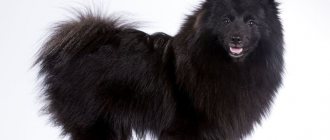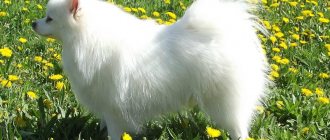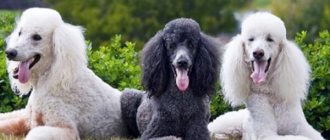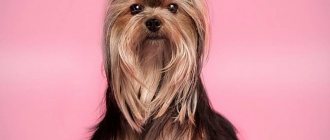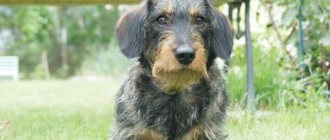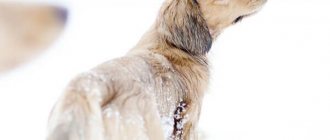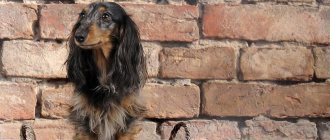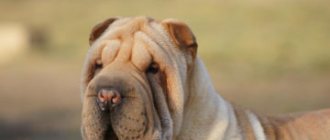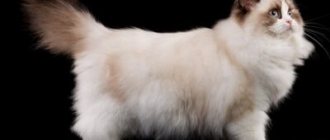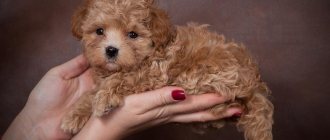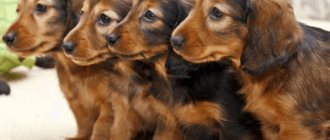The rabbit dachshund is very popular among dog breeders around the world. This is due to the fact that such animals are small in size, but they are quite attractive and also brave. This animal was initially used as a hunter's assistant, but nowadays the rabbit dachshund lives in city apartments, country houses, etc., being a pet.
Despite this, hunters still take advantage of the unique hunting abilities of this dog, but for this it must be trained.
What does a rabbit dachshund look like?
She is easily remembered for her appearance. An elongated body and small short legs are their distinguishing feature. The rabbit species differs from the ordinary one only in size. Other external features include:
- hanging ears;
- the tail tapers towards the end;
- The front legs are larger than the hind legs. But both couples are strong and muscular;
- head held high.
Character and behavior
The distant hunting past has affected the temperament of the rabbit dachshund. Her energy and high activity cannot be taken away from her. The main thing is that you should not neglect education and training so that these traits do not turn into a disadvantage. Other equally striking features include:
- Bravery and bravery. “Rabbits” are quite small and funny, but this does not at all prevent them from rushing into battle with ill-wishers without fear and doubt.
- Curiosity. They love to discover and learn new things. Therefore, in order for your pet to always be in an upbeat and cheerful mood, you often need to take him to places where he has not been before.
- Love for people. They become very attached to a person and worry if he is away from home for a long time. In addition, dogs love children and get along well with them.
- Good mental health. The nervous system is not subject to disturbances.
- Emotionality. Thanks to expressive facial expressions, it is easy to understand about her current emotions and feelings.
Dachshund rabbit color
This purebred dog has a lot of color options, which will be discussed later in the article.
Chocolate
This color means a light shade of brown with tan, the color of milk chocolate.
Ginger
Orange individuals often have coal hairs that grow mixed with the main ones.
Marble
There are brown and charcoal marble. This implies that there are stains on the base color of the body.
Boar color
The color is so called because of its resemblance to the color of the boar's bristles. That is, each hair contains orange and charcoal pigments.
Black
It is an intense and bright charcoal color, without any spots or additional shades.
Black and Tan
This color is considered a classic. With it, there are tan marks on the face, chest and paws of a reddish-red color.
White
White coloring is not limited to albinos. The white individual has a dark nose, eyelids and lips.
Grey
With a gray color, the tan is almost invisible.
Blue
This color is close to gray, but has a bluish tint. And if there is also a tan, then the dog will look pure blue.
Brown
The brown color is usually quite intense and expressive. If the tan marks are reddish in color, then the dog is brown and tan.
Cream
This color is not found in individuals with short coats. Cream is close to white, but has a yellow or apricot tint.
brindle
With this color the baby will look like a real tiger cub. Uniform dark stripes covering the body stand out clearly against the general background.
Sable
An interesting and unusual color that visually creates a sputtering effect: the tips of the coat are painted charcoal.
Double merle
The double merle color means that the pure white coat has marbled spots.
Isabella
This is the name of a color similar to coffee with milk, i.e. the color of clarified chocolate, similar to beige.
Spotted
Similar to the double merle color type, however the spots can be of different colors.
Two-color
With this color, there are large spots on the fur coat of a color different from the main one.
Miniature rabbit dachshund fur
Shorthair
This is the most common type, otherwise called smooth-haired. The length of the fur coat does not exceed two centimeters.
Longhair
In such individuals, the fur can reach a length of up to five centimeters. Especially long hair grows on the tummy, tail and chest. Such a fur coat requires careful care because it gets dirty faster.
Dimensions and weight of an adult dog
The final parameters of a rabbit dog are formed no earlier than at the age of fifteen months. The height of a mature individual at the withers is about twenty centimeters. And the weight, as a rule, is no more than three kilograms.
Rabbit Dachshund Breed Standards
The reference characteristics are established by the Federation Cynologique Internationale (FCI). They describe the ideal representative of the rabbit dachshund. Typically, this information is required for show pets and experienced breeders. So, the signs include:
- Body structure. It should be elongated and compact. The chest is oval, with developed ribs. The tummy is toned.
- Shape of the skull and head. It should taper towards the nose, and itself have an elongated shape.
- Bite. It must be correct, that is, the upper and lower jaws close tightly.
- Size and position of the eyes. The eyes are set wide apart and have an oval shape. Convex ones no longer fit the “standard”.
- The tail is at the same level as the back.
- The paws are clearly muscular and strong. The pads on the paws are plump and elastic.
Coat types
- Smooth-haired. The coat does not exceed 1 cm in length, smooth, close to the body, not rough. The undercoat is also short, soft, but not fluffy.
- Long-haired. On the body, limbs and ears, the hair is wavy, thick and quite long - from 5 to 10 cm. On the head it is short, smooth and close-fitting.
- Wirehaired. The coat is short - up to 3 cm, wiry, thick and dense. On the face it forms eyebrows, mustache and beard, typical for this variety.
Pros and cons of a miniature dachshund
The advantages of having such a baby in the house are:
- Intelligence and intelligence.
- Ability to learn quickly.
- Love for people.
- Knows how to express his emotions.
- Devotion.
- Funny appearance.
The objective disadvantages are as follows:
- Without proper attention and education, the baby will become overly stubborn and disobedient. This will lead to the fact that she will begin to spoil and break things, bark incessantly and rush around the house;
- hunting instincts. This becomes a problem if there are small animals (hamsters, rats, etc.) or birds at home.
Character
Representatives of the breed are companions for the owner and his family. Dachshunds are perfect for living in a large family with children, for one person, or for the elderly. If there is a child in the house, the pet will become for him, on the one hand, a toy, a partner in fun, amusement, and on the other, a protector, nanny, and security guard. However, Dachshunds will not tolerate bad treatment. If children and adults treat them inappropriately, the animals will not tolerate it. They will definitely fight back either with their behavior or even with aggression.
Distinctive character traits are activity, energy, and curiosity. If you plan to keep your dog alone within four walls all day, it is better to choose a different breed. Bonded to people, cheerful dachshunds will not survive in such conditions. They experience a long separation from their owner especially acutely.
The hunting skills of the representatives of the breed, which are in their blood, periodically make themselves felt even to dogs that have lived their entire lives as decorative pets. If a rodent or other small animal runs nearby, the dachshund will immediately react and be ready to chase it.
The hunting instincts of the rabbit dachshund prevent it from living peacefully in the same house with other animals, especially rodents. Small puppies can play with them, and over time they will begin to see them as their target.
The mini rabbit breed is small in size and weight. Despite this, the pet is always ready to defend its owner and his property when danger arises. The guarding instinct appears in puppies immediately after birth. High intelligence does not allow them to behave inappropriately. They will never attack first or show causeless aggression.
Dog care and maintenance
The baby is not capricious and unpretentious, but this does not mean that she does not require proper care and education. After all, the lifespan of a pet depends on proper care.
Feeding your pet
You can feed them with ready-made dry food or create a diet made from natural products. In the first case, you need to choose well-known brands of manufacturers with proven quality, who are conscientious about creating food.
It is better to avoid economy-class products, because they not only contain few beneficial microelements, but also many harmful ones. Well-proven feeds include the following:
- "Royal Canin Dachshund Adult." This is a French product that is in great demand. However, it contains a lot of carbohydrates and other additives. Therefore, its quality is regarded as average.
- "Eukanuba Breed Specific Dachshund". Dutch-American premium food. The quality is also average.
- The highest quality food is considered to be the holistic food “Almo Nature Alternative” from Italy. It contains no potential allergens or excessive amounts of carbohydrates. Owners note that after switching to this food, the pet’s health improves and there are no problems with stool. The only negative is the price.
In general, any holistic approach is an ideal option for a four-legged animal. Neither premium nor super-premium food will provide him with a complete supply of the necessary vitamins and minerals.
If the owner is determined to feed his pet natural products, he needs to know the rules of such nutrition. And first of all, you need to remember those types of food that are prohibited to give:
- Pork, lamb (and other fatty types of meat).
- Smoked, sweet and flour products.
- Potato.
- Seasonings, spices, salt.
What to feed the dog? Permitted and useful products include:
- Turkey, lamb, beef (lean). In general, meat should make up 40-60% of a pet’s total diet. Chicken often causes allergies, so it should be given with caution or avoided altogether.
- Sea fish. Naturally, without bones. It is better to avoid river fish, but there is no strict ban on its consumption. The main thing is to cook it and make minced meat to destroy possible parasites.
- Porridge. Rice, buckwheat, oatmeal are the most suitable. There is no need to give pea, pearl barley and corn cereals.
- Raw vegetables and fruits.
- Milk and sour milk. Low-fat kefir, natural yogurt, yogurt, etc. - all of these are valuable sources of protein and healthy fats. But milk should not be given after reaching three months of age - this causes diarrhea.
You must ensure that your dog always has access to clean, filtered water. It needs to be changed daily.
You cannot combine feeding with prepared foods and natural products. This will greatly affect the pet’s digestive system and create an unbearable burden on it.
You can’t overfeed either: the dog is prone to obesity.
Walking outside
The dachshund is always full of activity and a desire to frolic. Therefore, walking is a daily activity. You need to walk your pets for an hour or two every day (more is possible).
The walk should include:
- Active games. You need to be careful and not let the dog jump down from a great height. Due to the nature of her body, she is easily injured.
- Teaching commands and practicing them.
- The ability to run without a leash (but only if the dog knows the “come to me” command).
If it's quite cold outside, you need to put a jumpsuit on your baby. Otherwise, she may get wet, freeze and get sick.
Training and raising a dog
Without education and training, an active rabbit dachshund will turn into a real problem. You need to start working with the puppy at a very young age. Kids are smart, but sometimes they can be stubborn. Therefore, the owner must be patient and work persistently.
Experienced breeders advise punishing a pet for disobedience by ignoring it. You can’t shout at him, much less raise your hand. This will discourage your pet from working and may make him angry.
The very first thing you need to teach your dachshund is going to the toilet. At the same time, you need to accustom her to a leash.
Commands that can be taught to a dachshund:
- "To me".
- “Ugh,” “No way.”
- "Lie".
- "Wait".
- "Sit".
Hygiene, grooming
Rabbit dachshunds have delicate skin, so they are bathed quite rarely. This will only be necessary in cases of heavy contamination. The dog must be washed using a special dog shampoo. If it gets a little dirty, it is better to use a cloth soaked in warm water.
Dachshunds with smooth or short coats should be brushed twice a week, especially when shedding. To do this, you need to purchase either a brush or a special rubber glove. Wire-haired pets need to be trimmed periodically with a trimmer.
Mating a rabbit mini dachshund
Sexually mature individuals are ready to continue the race by one and a half or two years. It is not recommended to breed a female during her first heat, because she has not yet had time to fully form and get stronger. A direct meeting of the male and female must be organized on the territory of the former.
Before knitting a mini pair, you need to give them anthelmintics and treat them against skin parasites. This is necessary not only to prevent infection of each other. The fact is that the pregnant female and her future offspring will be harmed by anti-parasitic treatment.
Diseases, vaccinations
Rabbit dachshunds are prone to a number of diseases, including:
- Obesity.
- Epilepsy.
- Spinal dysplasia (i.e., underdeveloped bone and cartilage tissue).
- Diseases of the ears, joints.
Vaccination is an important procedure aimed at preventing a number of serious infectious diseases. Approximate vaccination schedule:
- At 2 months: first vaccination against plague, hepatitis, enteritis, adenovirus.
- At 2 and a half months: revaccination against the same diseases.
- At 6-7 months: vaccinations against the same diseases are repeated, and vaccination against leptospirosis is performed.
- At 1 year of age – rabies vaccination.
Origin story
Archaeologists find drawings of dogs with an elongated body and short legs in ancient Egyptian tombs and the cultural heritage of Ancient Greece and Rome. But confirmed data about the ancestors of the dachshund were found in Germany. Historians date the skeletons of dogs very similar to the dachshund to the heyday of the Roman Empire.
Initially, the cause of the non-standard build of dogs was diseases or mutations. In fact, dachshunds are dwarfs.
Badgers became a real threat to German agriculture in the 16th century. Cunning and cautious animals collected a decent part of the harvest and hid in holes, from where it was problematic to get them out. The dachshunds came to the rescue. Short legs and a flexible body allowed the dogs not only to move, but also to maneuver in narrow holes.
Demand creates supply. The first breeders appeared in the 17th century. But each of them had their own opinion on what an ideal dachshund should look like. Therefore, there was no talk of a single standard. At this moment, representatives of the breed were divided into two types - working and decorative.
The name of the breed comes from the German word “daxa” - “badger”. But the full name of the breed is “daxund”, or “badger hound”. The official ancestors of dachshunds are German small hounds - brakki.
The European aristocracy valued hunting dogs, so dachshunds appeared in almost every pack. But large individuals often got stuck in burrows, requiring a reduction in the size of the breed. The dachshund’s task did not include a fight with the animal; the dog was required to lure the badger or fox out.
Attempts by owners to breed smaller dachshunds began from the very moment these dogs were used for hunting. For this purpose, the smallest individuals were selected and crossed. The appearance of small puppies was considered great luck. Hunters were willing to shell out good money to become the owner of a miniature dachshund.
Understanding of the possibilities of selection and the desire to obtain a sustainable result came together only at the beginning of the 20th century, when professional breeding of the smallest dachshunds began.
Today, the rabbit dachshund is one of the officially recognized varieties of the breed and the smallest of all dachshunds. And if hunting for foxes and badgers has ceased to be widespread, then the rabbit dachshund continues to be popular as a pet and a regular at exhibitions.
Life expectancy of a rabbit dachshund
The lifespan of a rabbit dachshund is between twelve and fifteen years. The better you take care of your little pet, the longer he will live. However, in addition to this, predetermining factors for life span include:
- Genetic predisposition.
- Vaccination.
- Presence of congenital diseases.
- Was castration done? It extends life by several years.
What is the difference from the breed standard?
There is confusion here regarding the name of one of the types of dachshunds - “standard”. The breed is divided into three types, each of which is included in the standard:
- standard – height from 20 to 27 centimeters and weight up to 9 kilograms;
- dwarf - from 14 to 21 centimeters, weighing from 4 to 5.5 kilograms;
- rabbit - no more than 15 centimeters, weighing around 3.5 kilograms.
Thus, the rabbit dachshund differs in size from the standard one, but this is not a deviation from the breed standard. This is the smallest dachshund of all.
Price of a rabbit dachshund, where you can buy a puppy
You should buy a rabbit dachshund no earlier than it is 2 or 3 months old. You can do this:
- In the nursery.
- From a trusted breeder.
- On the Internet platform (Yula, Avito, etc.).
The price of a puppy will depend on whether it is bought for an exhibition or not, and on its pedigree. When purchasing, the baby must have all the required documents (passport, vaccination card). The average price of a rabbit dachshund is 10-12 thousand.
Marriage or breed
Typically, mini versions of dogs are considered a defect and a deviation from the breed standard. But, in the case of the rabbit dachshund, the situation is the opposite. The efforts of many breeders were aimed at reducing the classic size. The dwarf rabbit dachshund is one of the three official types of the breed, its parameters are included in the international standard.
Rabbit dachshunds successfully take part in hunts and exhibitions, and bring joy as a companion. There can be no talk of any marriage.
Reviews from rabbit dachshund owners
Maxim, Moscow:
“We bought a rabbit dachshund from a nursery, the baby quickly got used to us. Gets along great with children. And a two-hour walk every day is beneficial not only for the dog, but for all of us.”
Angelina, Kazan:
“We really wanted a rabbit dachshund, but we were worried that he wouldn’t be able to get along with our middle-aged cat. But everything went smoothly. Now they play together. The active dog never sits idle for a second. He's fun and funny to watch, especially when he's playing."
Artem, St. Petersburg:
“A very kind and loyal dog. He always greets me and rejoices at my arrival. And it’s a real pleasure to train, the dachshund is smart and quick-witted.”
Popular nurseries
- Golden Daxhund, Moscow region, Odintsovo
- From Omsk Fortress, Omsk
- Caladium Vis-a-vis, Moscow
- Caroline Yudzhel, Moscow
- Kinchville, Moscow
- Fox Nose, St. Petersburg
- Minidogland, Smolensk
- Myshkin House, Moscow
- Magic Rainbow, St. Petersburg
- Norden Licht, Moscow
- Rus Bramers, Moscow
- From the Marvelous Mountains, Krasnoyarsk Territory, Divnogorsk
- Stayer's, Tula
- Formula for success, Moscow
- Certus, St. Petersburg
You can easily find the websites of these nurseries on the Internet, as well as the coordinates of their owners.
Flaws
If a pet has the following defects, it may be disqualified from the exhibition:
- Wavy or soft coat for wire-haired representatives.
- All varieties have long hair except longhaired ones.
- Blue eye color, except for merle-colored pets.
- Excessive hair or lack of hair on the tail.
- Folded ears or folded ears.
- The hind limbs are narrowly spaced.
- No markings on the black color.
- Long-haired animals have short hair.
- The back is hunchbacked or sunken.
- The croup projects higher than the withers.
- Bald spots, sparse hair.
- Incomplete number of teeth.
- Underdeveloped sternum.
- Nervousness, aggression.
- Broken bite.
- Weakness of the body.
- Clumsiness.
- White wool.
Description
The mini dog differs from its relatives in its elongated muscular body, very short legs, floppy ears, miniature size and typical muzzle. The standard requires the dog to have an elongated wedge-shaped head that is positioned high. The flat forehead has a pronounced occiput, and the transition of the muzzle to the skull is blurred. The bridge of the nose is distinguished by straight lines, it is narrow and long. The nose should be red-brown or black.
The lips are close-fitting, with characteristic pigmentation for black coats and brown for brown coats. The pet has a knife-like bite that closes tightly. Oval eyes are colored in shades from black-brown to red-brown. A merle-colored animal can have a “pearl” or blue color. The eyes are medium-sized, not too large, and have rims around the edges.
Nutrition
The rabbit dachshund has a greater need for energy reserves than large breed dogs.
For 1 kg of weight she needs 85-90 kkl, while a large dog, for example, an Alabai or a Tibetan mastiff , needs only 50 kkl.
To maintain energy in an adult dachshund, food should contain as little fat as possible.
When an adult dog continues to be fed puppy food high in fat, he is at risk of becoming obese.
The diet of an adult rabbit dachshund should consist more of fiber rich in carbohydrates.
You can use high-energy dry food designed for dogs with increased activity.
You need to feed your dachshund strictly twice a day, and do not teach him to snack in between.
Combing
Smooth-haired dachshunds are always ready for a show. Their coat is always perfect, it does not require additional care or combing, and dirt does not stick to it. The same can be said about wire-haired dachshunds.
It is enough to clean these varieties sometimes with a brush, starting from the head and throughout the body in all directions.
Rabbit dachshunds with long hair look more decorative. They periodically need to comb the fur on their limbs, undersides and tail.
Brush dogs with a brush made of natural bristles, which is not capable of damaging the skin. Care should be taken to ensure that the hair behind the ears does not form clumps.
Long-haired breeds should be combed with a furminator - this device is ideal for caring for your pet during shedding.
The dachshund is sanguine by temperament and has a strong, stable character.
